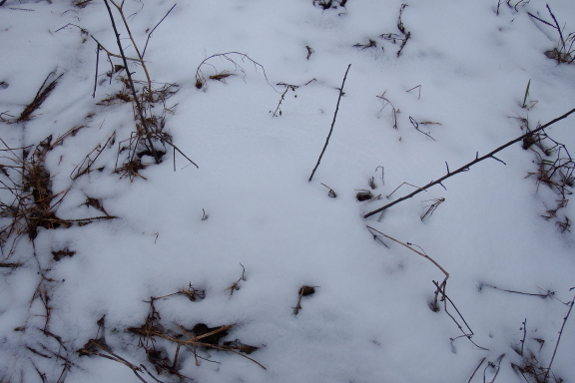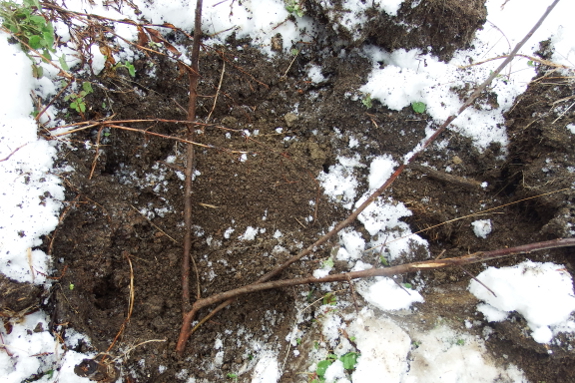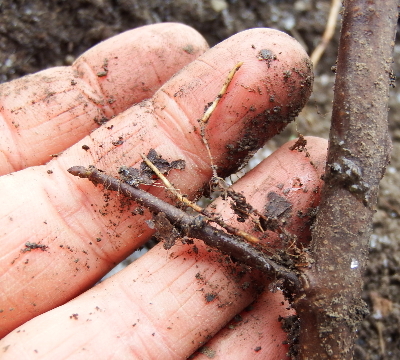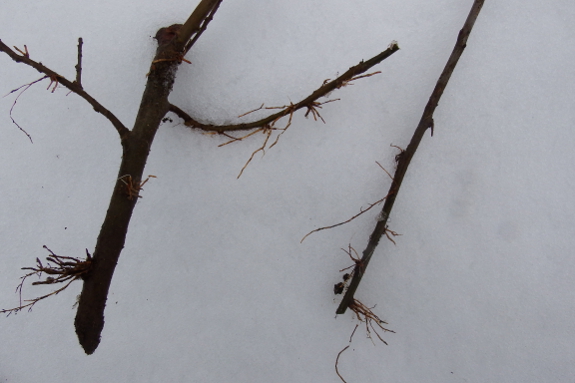
Homegrown apple rootstock

I dug into my stooled rootstocks
this week to see if I had any cuttings to turn into new trees. I could
tell you lots of reasons why this was the right time to take a look
inside the mound. But the truth is that our earth had been snow-covered
for quite a while and I was antsy to get my fingers into the dirt.

 Rootstock
mound #1 looked good from the outside. I'd hilled up the dirt pretty
high, and there were three good shoots sticking out the top. But when I
broke through the frozen ground to reach the interior, all I found was
one little cluster of roots --- not enough to keep the plant alive if I
severed it from the base.
Rootstock
mound #1 looked good from the outside. I'd hilled up the dirt pretty
high, and there were three good shoots sticking out the top. But when I
broke through the frozen ground to reach the interior, all I found was
one little cluster of roots --- not enough to keep the plant alive if I
severed it from the base.
For those of you keeping
track at home, this is a M26 rootstock leftover from a winter-top-killed
tree planted a little over three years ago. I figured since the
rootstock was still sprouting despite the loss of the scionwood, I'd
turn the plant into a stool and use it to produce rootstock for the
future. And that may still work --- we'll see how the interior looks in
spring 2017. In the meantime, I covered the shoots back up and moved to
the next stool along the line.

Mound #2 is younger, but
is also a different variety. I bought an extra MM111 rootstock a little
less than two years ago specifically for rootstock reproduction. As with
the accidental rootstock, I cut back the primary shoot last spring,
then mounded up around the new branches
all through the summer. Digging into the stool now, I found two
passable rootstocks ready to be harvested for spring grafting. Success!
Want more in-depth information? Browse through our books.
Or explore more posts by date or by subject.
About us: Anna Hess and Mark Hamilton spent over a decade living self-sufficiently in the mountains of Virginia before moving north to start over from scratch in the foothills of Ohio. They've experimented with permaculture, no-till gardening, trailersteading, home-based microbusinesses and much more, writing about their adventures in both blogs and books.
Want to be notified when new comments are posted on this page? Click on the RSS button after you add a comment to subscribe to the comment feed, or simply check the box beside "email replies to me" while writing your comment.

I have been working at recreating an early 1900's orchard on our farm. My great grandfather was an orchard guy. He had quite a collection here. He and the orchard have all passed on. So, I'm trying to rebuild what might have been. I'm also in a very harsh climate; lots of wind and storms. Plus, I'm 'thrifty.' So I have been using standard apple rootstock and having great success. Standards are hardy, deeply anchored with great roots and they survive. The dwarfing stocks are quicker bearing, but that's about all you can say for them. (I'm not needing commercial output either.) I am 'dwarfing' with my chainsaw and good pruning management. After 14 years, I'm seeing great results.
Here's what I'm doing and I'm hoping this could work for you, too. First, eat apples. Second, put the seeds in a glass. Collect them dry. In April/May, soak the seeds in water for about 4 days. Change the water every day. The brown coating on the seed is a germination inhibitor. Soak that out. Next, plant the seeds. Guard them from mice - and in your case - goats. Let them grow for one season. You can bud graft them sometimes in the first fall. Otherwise, they are your bench whip-and-tongue stock for next year. Cheap, effective and very successful. AND, your new trees on standard stock will survive!
Tim --- Sounds like you have an amazing setup! Unfortunately, we just don't have room for many (well, really, any) standard-sized trees within our core homestead, and we'd have to clear a lot of forest to plant them elsewhere. It's still on our possible list, but not our right-now list.
T --- I accidentally made a long scratch in one of the stems as I was digging through frozen soil to get to it and had that same thought. Next time I'll make some intentional scratches and see if that speeds things up!